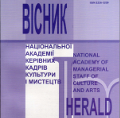ФОРТЕПІАННИЙ КОНЦЕРТ Й.Н. ГУММЕЛЯ № 2 А-MOLL OP. 85 В КОНТЕКСТІ МИСТЕЦТВА «ЛЕГКОГО» ПІАНІЗМУ БІДЕРМАЄРА ПЕРШОЇ ПОЛОВИНИ ХІХ СТОРІЧЧЯ
PIANO CONCERT BY Y.N. HUMMEL NO. 2 IN A MINOR OP. 85 IN THE CONTEXT OF BIEDERMEIER'S ART OF "LIGHT" PIANISM OF THE FIRST HALF OF THE 19TH CENTURY
Author(s): Juntao XuangSubject(s): Theatre, Dance, Performing Arts, Cultural history, Music, 19th Century, History of Art
Published by: Національна академія керівних кадрів культури і мистецтв
Keywords: piano Mozartianism; pianism; "easy"; "diamond" playing style; musical genre; style in music; concert;
Summary/Abstract: The purpose of this study is the analysis of Y.H. Hummel's Second Piano Concerto from the perspective of Biedermeier's positions of "light" ("diamond") pianism of the Restoration era, which deployed saving the spiritual foundations of Rococo in the conditions of secularised art of the post-Vienna school. The methodological basis of the research is the intonation approach of the school of B. Asafyev in Ukraine, which is embodied in the works of D. Androsova, O. Markova, O. Muravska, L. Shevchenko and has direct implications for the institutions of Chinese musicology (see the works of Ma Wei, Wu Golin, others). The specifics of the methods of historical-descriptive, musicological analytical, cultural, stylistic comparative, interdisciplinary approach make up the specifics of the research apparatus of the author of the essay. The scientific novelty of the work is revealed in the fact that, for the first time in Ukrainian and Chinese musicology, the so-called Concerto of Y.H. Hummel is analysed in the light of the positions of Biedermeier's "diamond" pianism of "light play" in the continuation of Mozartianism in piano works (based on the works of D. Androsova and L. Shevchenko) and in the development of the concept of neo-symbolism of post-avant-garde modernity according to O. Markova in relation to the performing revival of Hummel's heritage. Conclusions. Piano concert by Y.N. Hummel's A-moll op. 85 is marked by the advantages of pianistic lyrical flourishes over the manifestations of theatrical drama. The predominance of the lyricism of piano flourishes feeds the positions of romanticism against the background of Biedermeier's ideal expressive instructions, inspired by religious sobriety and, like Rococo art, addressed to the ideal aspirations of the soul and a harmonious worldview. In the Concerto, we rely on Mozartian tectonics (the theme of the soloist in the second exposition, mainly a compensatory function of the orchestra), the structure is dominated by exposition, which "washes away" the sonata relations. The predominant position of "piano lyricism" of ultra-fast finger "small technique", the presence of genres (signs of march, nocturne, anthem) in the expressiveness of themes, "obliteration" of tempo-textural contrasts between the extreme and middle parts of the cycle are evident. The features of crescendoing drama with increasing movement intensity from the beginning to the end of the concert cycle in a two-phase (Parts I-II-III) presentation of energy accumulation are revealed, which corresponds to the two-phase nature of the early Christian liturgy honoured by the Biedermeier culture.
Journal: Вісник Національної академії керівних кадрів культури і мистецтв
- Issue Year: 2023
- Issue No: 3
- Page Range: 322-327
- Page Count: 6
- Language: Ukrainian

